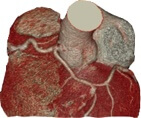A coronary artery anomaly is an abnormality in the course or location of one of the heart’s arteries. The anomaly can result in reduced blood supply to the heart or premature narrowing of the heart artery.

How common is it?
Coronary artery anomalies are quite common and are found in approximately 1 in 100 of the population.
What symptoms might I get?
Most people with coronary artery anomalies have no symptoms but some patients can present with symptoms of chest pain, giddiness or blackouts, usually with exercise.
Will I need treatment?
Usually not, although there are some types of coronary artery anomalies that can be associated with an increased risk of sudden cardiac death. Drug therapy with beta-blockers or heart surgery to realign the course of the blood vessel are occasionally used.
What extra tests are required?
A cardiac computed tomography (CT) scan or coronary angiogram will help identify the abnormal artery. Some patients require extra functional tests of the heart such as an exercise tolerance test or stress echocardiogram.
Is it hereditary?
No
Does this affect my life expectancy?
It can do – coronary artery anomalies are a recognised cause of sudden cardiac death.
What happens next?
If you have been diagnosed with a coronary artery anomaly then you can be referred to your local cardiologist for further imaging and investigation.
Useful links
http://en.wikipedia.org/wiki/Coronary_artery_anomaly